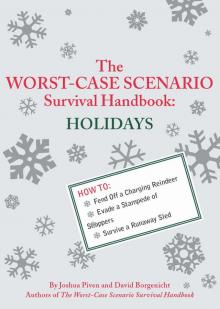- Home
- David Borgenicht
Holidays Page 2
Holidays Read online
Page 2
2. Dry the burned area gently.
Blot the injury site using a clean, dry towel or sheet.
3. Check for blistering.
If the blisters are small, pop them with a sterilized pin and remove dead skin using scissors. (Wiping the tip of a pin in alcohol or heating it in the flame from a match will adequately sterilize the pin.) If there are no blisters and the burn is less than one inch across, apply burn cream and a sterile dressing.
4. Cover severe burns.
If the burn is larger than one inch across or is very blistered, cover it with a clean, dry sheet or towel and seek medical attention promptly.
Be Aware
Infection is the main risk. Signs of infection include fever or local warmth, increased redness around the burned area, increased soreness, red streaks, swelling, or drainage of pus.
Do not apply oily or greasy substances such as petroleum jelly or butter to the wound. These popular but misguided burn remedies are detrimental to the healing process.
HOW TO REPURPOSE A FRUITCAKE
Turn the fruitcake into another dessert.
Do not serve the fruitcake as is. Slice it very thin, tear the pieces apart, and use them in an English trifle, a dessert made with alternating layers of cake (née fruitcake), custard, whipped cream, and, sometimes, fresh fruit. Serve in a deep glass bowl (often called a trifle bowl).
Use the fruitcake as a doorstop.
Fruitcakes are very hardy and will last for years. Use the fruitcake to prop open a door.
Use the fruitcake to prevent your car from rolling.
When parked on a hill, wedge the fruitcake under the downhill side of a rear tire. In your garage, position the fruitcake on the floor as a tire stop to prevent the car from hitting the garage wall.
Use the fruitcake as a dumbbell.
A good-size fruitcake may weigh several pounds. Incorporate it into your exercise routine, holding it firmly for arm curls, or squeezing it between the feet for leg lifts.
Use the fruitcake in a carnival game.
Collect fruitcakes and stack them vertically in a pyramid. Using tennis balls, try to knock down the fruitcakes in five throws.
Use as bookends.
Set up two fruitcakes either horizontally or vertically, depending on the size of the books.
Use as art.
Bolt a fruitcake to a painted board, frame it and hang it on your wall, or simply place it on a pedestal. Position the fruitcake in a well-lit area.
Use the fruitcake as compost.
Fruitcakes are made of (mostly) organic material, and make good fertilizer. However, it may take several years for the fruitcake to decompose.
HOW TO SAFELY EAT A FRUITCAKE
1. Slice it thin.
Cut the fruitcake into narrow slices—no more than 3/8 inch—while the cake is cool. Place the slices on a serving platter, cover, and allow to come to room temperature.
2. Check the knife.
After cutting, the blade should be somewhat sticky and slightly colored. If the knife does not have to be wiped with a damp cloth after each cut, the cake is too dry, and a healthy dollop of whipped cream will be necessary. If the knife is heavily streaked with cake ingredients after cutting, the fruitcake has not been baked long enough and may need to be repurposed.
3. Disguise the taste.
Cover with lots of ice cream and whipped cream. Wash the fruitcake down with strong black coffee, Irish coffee, brandy, or a hot toddy.
4. Swallow without chewing.
Cut the slice into small pieces. Swallow each piece whole, as you would a vitamin. If chewing is necessary, use your molars, not your front teeth or incisors, and try not to touch the food with your tongue, which has all your taste buds.
Be Aware
Do not be fooled by a gift of a “Yule cake,” “Christmas ring,” or “dried fruit bread”—these are just other names for a fruitcake.
If the fruitcake is very dark in color, it contains lots of molasses and corn syrup, making it exceedingly sticky, thick, and dense. The heavier the fruitcake, the more candied fruit and dark molasses it has. The darker or heavier the fruitcake, the more difficult it will be to swallow.
A light-colored fruitcake is a good sign; the cake has plenty of batter and light corn syrup.
Fruitcake should be stored in a cool place, such as a refrigerator or cellar. If kept cool and in a tin, the cake will last for at least a year, and you can give it as a present the following Christmas.
HOW TO OPEN A BOTTLE OF WINE WITH A BROKEN CORK
1. Examine the cork.
If the cork has broken due to improper corkscrew use, treat the broken cork as if it were whole. If the cork is pushed too far into the bottle, push it all the way in using any long thin implement and proceed to “With a Very Dry Cork,” step 5, below.
2. Reinsert the corkscrew.
Six half turns of the corkscrew will usually be enough to allow you to remove a full cork, but you may need fewer for a partial cork. Turn the corkscrew slowly to prevent further cork breakage.
3. Pull the cork out.
Pull up steadily on the corkscrew, being careful not to jerk the cork out of the bottle. If the cork remains in the bottle, go to “With a Very Dry Cork,” step 2, below.
WITH A VERY DRY CORK
1. Check for crumbling.
If the cork is soft and powdery, it will not offer the corkscrew enough resistance. It may also be stuck to the sides of the bottle, making intact removal impossible.
2. Bore a hole through the center of the cork.
Use the corkscrew as a drill.
3. Widen the hole.
Wiggle the corkscrew from side to side to increase the diameter of the hole.
4. Try to pour.
If the wine will not pour, continue to enlarge the diameter of the hole as above, or force the remainder of the cork into the bottle (see “How to Open a Bottle of Wine Without a Corkscrew”).
5. Make a filter.
Place a piece of clean, unwaxed, unbleached cheesecloth over the mouth of a decanter and secure it tightly with a rubber band. If no cheesecloth is available, use a coffee filter (preferably unbleached). Do not use a T-shirt or any article of clothing you have washed in detergent—the detergent can affect the taste of the wine.
6. Strain the wine.
Carefully pour the wine through the filter into the decanter. When the bottle is empty, remove the filter containing the pieces of cork from the mouth of the decanter and serve the wine.
HOW TO OPEN A BOTTLE OF WINE WITHOUT A CORKSCREW
It is virtually impossible to remove a cork from a wine bottle without a device made for this purpose. However, the cork can be pushed into the bottle with a little effort.
1. Hold the bottle steady with one hand.
2. Use a blunt, unbreakable, skinny object, such as a screwdriver, the handle of a wooden mixing spoon, or a butter knife to push the cork in.
3. Apply steady pressure and be patient.
You may carefully tap the end of the blunt object with a hammer or meat tenderizer to force the cork into the bottle more quickly.
HOW TO AVOID SHOOTING A CHAMPAGNE CORK
1. Hold the thumb of your non-dominant hand over the cage and cork.
The cork may fly out of the bottle as soon as the wire mesh (known as the “cage”) is loosened. Keep pressure on the cork and point the bottle away from yourself and anyone nearby.
2. Turn the key of the wire cage.
All cages on champagne and sparkling wine open after six clockwise half-turns. Remove the cage.
3. Place an opened cloth napkin over the cork and neck of the bottle.
Hold the bottle in your non-dominant hand and the napkin over the cork in your other hand. Keep the bottle angled away from people.
4. Hold the cork tightly and slowly turn the bottle clockwise.
Do not turn the cork or you risk breaking it.
5. As the cork begins to come out, apply downward pressure on it.
The pressure will prevent the cork from shooting away from the bottle.
6. Hold the cork at the mouth of the bottle for five seconds.
If champagne begins to bubble up and out, it will react with the end of the cork and flow back into the bottle.
7. Slowly pour the champagne.
Pour the champagne slowly until the froth (called “mousse”) reaches about 2/3 up the glass, then pause. When the mousse has receded, continue filling until the glass is approximately 2/3 full.
Be Aware
The quieter the pop, the better the opening.
A poor opening will cause champagne to spurt out of the bottle, resulting in lost champagne and carbonation.
An uncontrolled opening may result in the cork leaving the champagne bottle with enough force to cause injury to someone nearby.
Crystal flutes will improve the champagne experience: The slender shape makes the long streams of bubbles more visually appealing and concentrates the aroma. The finest leaded crystal (with a lead content of about 25 percent) has the smoothest surface and allows the champagne to maintain maximum carbonation.
Never chill champagne flutes.
Avoid champagne “saucers”: Their larger surface area releases more carbonation.
The smaller the bubbles, the better the champagne.
CHAPTER 2
FRIENDS AND FAMILY
HOW TO DEAL WITH A MEDDLING PARENT
1. Prepare yourself mentally.
Remember that the holidays are a time for celebration, and try to maintain a positive attitude no matter what your parents may say.
2. If your parents give unwanted or annoying advice, be polite and attempt to change the subject.
Thank them for their concern. Say, “I appreciate your advice, but I’d really rather talk about [insert new subject here].”
3. Avoid confrontation.
Never respond to a meddling parent with phrases that include “you always,” “you never,” or “leave it alone.” Suggest discussing the issue at another time. If you are a guest in someone else’s home, confrontation should be avoided at all costs.
4. Smother the conversation with kindness.
Always counter a negative remark with a positive one. If your parent says, “Your house really needs painting,” counter with, “This house is in such a great neighborhood. Isn’t that great for the kids!” If your parent says, “When are you going to get a real job?” counter with, “I’m making great progress on my novel!”
5. Do not discuss money in public.
How much things cost and financial success are attractive topics for a meddling parent. These are in-appropriate subjects for group conversation, however. Do not get angry; deflect the inquiry. If a question about money is asked, say, “I can’t remember what we paid,” or “We’re just thankful for what we have.”
6. Avoid taking the bait.
If a meddling parent keeps mentioning how well other people are doing compared to you—how important a job, how many children, how big a house—or makes other implicitly critical comparisons, just say, “That’s wonderful.”
7. Ask for their advice about a less-irritating topic.
Meddling parents often simply want to be asked for their opinions. Seeking their thoughts on a less important subject or even on a made-up problem may placate them or distract them from sensitive issues (ask for their input on remodeling the kitchen, for example, even if you are not intending to do so).
8. If the meddling parent will not relent, excuse yourself from the conversation.
Casually excuse yourself (do not say, “I can’t listen to this anymore!”) and move to another room. For example, finish your drink and say, “I need to get a refill” (do not offer to get your parent one); or say, “Excuse me, I have to go to the bathroom,” or “I have to make a phone call,” or “I promised I would help in the kitchen.” Do not make any promises to come right back.
Be Aware
It is best to preempt meddling parents by announcing lots of news before the holidays arrive. Phone or e-mail the week before with updates, keeping the news positive and upbeat.
Remember that you do not have to answer every question. In advance of the holidays, practice non-responses or evasive responses, such as “Do you really think so?” or “That’s an interesting question. Let me think about it.” In front of a mirror, practice the blank stare.
HOW TO SURVIVE IF YOU HAVE NO ONE TO KISS ON NEW YEAR’S EVE
IF YOU ARE WITH OTHERS
1. Keep a glass in your hand.
If others think you are being festive and uninhibited, you are much more likely to receive a kiss. Even if you are not drinking, always hold a partly full glass of champagne.
2. Hug people.
As the clock strikes midnight, begin hugging everyone around you.
3. Select a desirable person.
As you are hugging, look for an attractive person who you would enjoy kissing and who might kiss you. If a person is not randomly kissing others, he or she may be less likely to kiss you.
4. Begin your approach.
Act casual, but keep your destination in view. Slowly move toward your chosen one, hugging everyone on the way.
5. Time your arrival.
Do not appear to be “lining up” to kiss this person. Time your arrival precisely as the person releases the previous reveler.
6. Yell first, then hug.
Yell “Happy New Year!” as you move in. Hug, embrace, then pull away slightly.
7. Kiss.
Keep your mouth closed, pucker slightly, and plant the kiss.
IF YOU ARE ALONE
Kiss a pet.
Dogs are generally agreeable and have relatively clean mouths. Cats are usually well groomed but are more passive and tend to get rather than give. Keep your mouth closed.
Kiss yourself.
Find a mirror, pucker up, lean close, and kiss. Keep the lips slightly parted. Do not attempt to use your tongue. Wipe the mirror clean after you have completed your kiss. You may also try kissing the back of your hand.
Kiss a celebrity.
Watch a favorite movie or show on television and kiss the screen when an appealing star has a close-up.
Wipe the screen first to remove dust and static electricity, and wipe the screen after to remove any evidence.
Hug a pillow.
Full-body pillows are more satisfying.
Call a friend on the phone.
After you wish your friend a happy New Year, give the telephone mouthpiece loud, smacking kisses. (This works less well with cellular phones.)
HOW TO FEND OFF AN UNWANTED KISS
ON ARRIVAL
1. Carry a present, coat, hat, or child in front of you as you enter.
2. Extend your free arm in a wide arc and move into a hug position.
3. If the greeter leans in to plant a kiss, use the head-and-shoulders maneuver.
Move your head toward the kisser, then at the last moment, rotate your shoulders, throw your arm around, and bury your head in the kisser’s neck.
UNDER THE MISTLETOE
1. Find the mistletoe.
As soon as you arrive, determine the location of the mistletoe. Check the lintel over doorways and hanging lights, which often obscure the mistletoe.
2. Establish alternate routes.
Avoiding the mistletoe is the best defense. Plan your comings and goings so that you do not pass under the mistletoe.
3. Employ evasive maneuvers.
If the mistletoe is hung in an inescapable location and someone is approaching, be prepared to use counter-measures:
Keep walking, as if you didn’t realize you were under the mistletoe.
Carry a drink or plate of food at all times, and quickly take a sip or bite as the person approaches.
Sneeze, cough, or scratch your nose just as the person moves in. When they hesitate, turn the attempted kiss into a friendly hug.
Move rapidly and place a preemptive, glancing kiss on the person
’s forehead or cheek, thereby avoiding a more serious kiss.
4. Make up a mistletoe-related fib.
When fleeing from the would-be kisser seems too rude and other defensive tactics won’t work, create a new mistletoe custom that would preclude the kiss:
“This mistletoe has no berries! That’s bad luck!”
“That’s not real mistletoe, it’s plastic! How tacky—we can’t kiss under that!”
“Can you believe they put up mistletoe? Who believes in that anymore?”
Be Aware
Portable mistletoe—a sprig attached to the end of a curved stick—is not valid mistletoe and does not invoke the kiss tradition. (You might also question why you are attending a party with someone who would attempt the “mistletoe-on-a-stick” trick.)
Do not attempt to avoid a mistletoe kiss by claiming that you are not Christian. The custom of kissing under mistletoe is not specific to Christianity and is observed in many religions and countries.
HOW TO OVERCOME HOLIDAY DEPRESSION

 Extreme Junior Edition
Extreme Junior Edition Middle School
Middle School The Worst-Case Scenario Survival Handbook: Middle School
The Worst-Case Scenario Survival Handbook: Middle School Junior Edition Bundle
Junior Edition Bundle The Worst-Case Scenario Ultimate Adventure Novel: Deadly Seas
The Worst-Case Scenario Ultimate Adventure Novel: Deadly Seas Holidays
Holidays Ultimate Adventure Novel: Mars
Ultimate Adventure Novel: Mars Ultimate Worst-Case Scenario Survival Handbook
Ultimate Worst-Case Scenario Survival Handbook